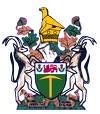Lady Courtauld's Gemstone Collection

PRODEANT VEXILLA
This brochure is intended to serve as a lasting reminder of a visit made to the Permanent Gemmological Exhibit founded by The Standard Bank Limited at Salisbury, Rhodesia.
The Standard Bank Limited, the first Bank to commence business in Rhodesia, has had intimate links with all sections of the economy since the first Branch was opened in Salisbury a little less than two years after the arrival of the Pioneer Column, an event which signalled the founding of Rhodesia. Not the least of these intimate links has been that with the mining industry and it is. perhaps, appropriate that the unique home' of the Bank's Permanent Gemmological Exhibit is in the form of a mine adit or tunnel.
With the growing world-wide interest in gems and minerals, the Standard Bank decided to set aside a portion of the Banking Hall of one of its many branches in Salisbury as a permanent home for the display of— in particular—Rhodesian gemstone material and mineral specimens given to the Bank over the years by mineral prospectors, customers in the mining industry, etcetera, and to house privately owned collections of this nature handed to the Bank on loan or to be held in Trust, temporarily or permanently, for public display. It was felt that a permanent exhibit of this nature would be a means by which unique gemstones and mineral specimens representative of Rhodesia's heritage could be retained in the country for the benefit of posterity and there can be no doubt that the Exhibit will be of absorbing interest to residents of Rhodesia and visitors to the country, alike.
The Permanent Gemmological Exhibit, which will be open, free of charge, to all sections of the population during normal Banking hours, has been staged in a manner which, of itself, creates an atmosphere of interest. The 14 cabinets, individually illuminated through pressure on a time switch, are at eye level and are set into the 'walls' of the simulated mine tunnel. The lighting system has been arranged so as to increase the impact of the display but, at the same time, tominimise the heat build-up from the high intensity lamps; in the latter regard an interesting feature of the tunnel is the authentic 'mine' ventilation system installed for the comfort of viewers of the exhibits.
The central feature of the Gemmological Exhibit is a collection of gemstones given to the National Museums of Rhodesia by Lady Courtauld and known as "Lady Courtauld's Gemstone Collection". The Bank is privileged to have been authorised to hold the collection for public display, on loan from the National Museums. In conjunction with this acknowledgment of the Bank's indebtedness to the National Museums for allowing Lady Courtauld's Gemstone Collection to form the nucleus of the Permanent Exhibit, the Bank records its sincere thanks to the following persons and companies who have provided exhibits: —
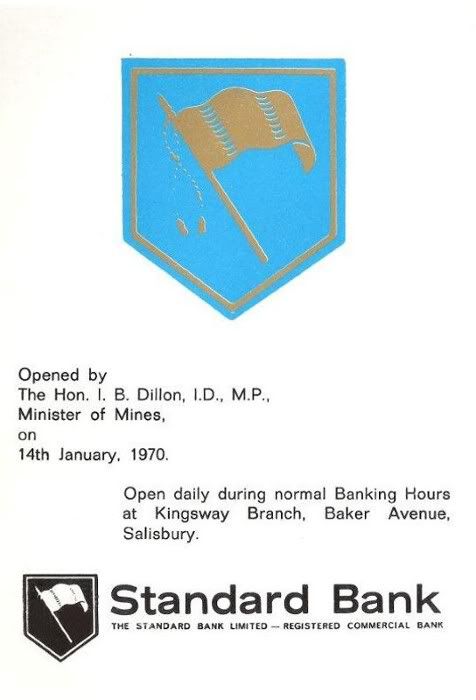

Cabinet 13
R. A. J. Catley, Esq.
Cabinet 2
Central African Diamond Cutting Works (incorporating Keays Jewellers)
Cabinet 14
L. J. Contat. Esq.
Cabinet 1
J. Kanis & Co. (Pvt.) Ltd.
C. L. S. H. Mitchell, Esq.
Beryl specimen at entrance to Exhibit.
In addition to the gemstones and mineral specimens on display at the present time, the Bank has received many other valuable items which will be placed in the Permanent Exhibit at a later stage under acknowledgment to the various donors.
CABINET No. I
J. Kanis & Co. (Pvt.) Ltd.
BERYL
Dr. J. Kanis, a leading gemmologist, has selected beryl which is widely distributed in Rhodesia, as the theme for this cabinet, partly because of the economic importance of the mineral and partly for its universal acceptance in its purest form as a gemstone. The non-gem variety is known as commercial beryl and is the source of the rare metal beryllium which is used as a constituent of specialised alloys and in atomic reactors. Pure beryl is colourless but due to the almost invariable presence of tinctorial agents, it assumes a wide variety of colours. The best known of the beryl group is emerald. This grass-green variety of beryl is coloured by a small amount of chrome being incorporated into the crystal lattice of the stone. The sea green to blue stones are known as aquamarine, the rose-red as morganite and the yellow as heliodor or golden beryl. Ferric iron accounts for the blue and green tints, lithium for the blush of morganite. Iron, and the percentage content of beryllium in the specimen produces the yellow tints. The peach coloured morganite weighs 45.78 carats and was cut in Rhodesia, as were the other stones on display. The series of cabuchoned stones show the diversity of colour found in Rhodesian beryl.
CABINET No. 2
Central African Diamond Cutting Works Incorporating Keays Jewellers.
DIAMOND
No display of gemstones can be complete without the most popular of them all, the diamond. Everybody knows the saying "Diamonds are a girl's best friend" but, as is well known, besides being much valued for adornment purposes the diamond is In great demand for industrial purposes. It is the hardest substance known to man; its beauty is undoubted and rarity is maintained by the exceptional world demand for this stone.
Although most diamonds appear to be colourless, there is often the faintest tinge of yellow, though this is only recognisable by the expert. The blue-white diamond is very rare and therefore very expensive. However, once a diamond attains a true yellow or golden shade it becomes a fancy diamond and is similarly priced. Diamonds have colours that range through the yellows to coffee brown, and in black, red, pink, green and blue, although some of the colours are extremely rare.
This fine display of very valuable diamonds shows not only the beauty of these stones but local craftsmanship, as they have all been cut in this country.
CABINET No. 3
Lady Courtauld's Gemstone Collection
FLUORSPAR, CHRYSOBERYL, ZIRCON AND DIAMOND
Fluorspar, too soft for use as a gemstone for jewellery, is frequently encountered as cut specimen stones. The two larger specimens, of a green and blue colour, and the four smaller stones, are collectors items showing the workmanship involved in cutting and polishing this material.
An exceptional chrysoberyl weighing 49.38 carats is displayed on the base of the cabinet, together with a diamond crystal which has been included as diamond, is seldom seen in its natural form. The two yellow stones on the glass stand are othoclase feldspar and, again, are exceptional specimens due to their size, colour and clarity. They weigh 92.42 carats and 22 carats respectively.
The selection of zircons in this cabinet show the remarkable reflective quality of these stones in many of the more desirable colours.
CABINET No. 4
Lady Courtauld's Gemstone Collection
QUARTZ GEMS
(Citrine, Amethyst and Rock Crystal)
Although quartz is the most common of minerals its gems are by no means the least desirable; no other specie supplies stones in quantity of such a rich purple shade as that exhibited by amethyst. The yellow quartz can vie with topaz in the elegance of the stones it produces, so much so that there has long been the practice of describing both species as topaz; this misleading habit is being actively discouraged and the term citrine is proposed as the more suitable title for these yellow stones. Cairngorm is an acceptable name for quartz of a brownish or smoky shade of yellow, and morion for the darker varieties. Even the rather despised clear quartz or rock crystal produces sparkling stones of no mean appeal .Other attractive colours can be produced by the heat treatment of amethyst, notably a very rich golden brown stone, termed "burnt amethyst", and green stones from certain amethysts from Brazil. Whilst these are the quartz gems most commonly faceted, there are many other varieties that are occasionally faceted as curiosities, or provide attractive stones when cabuchoned.
CABINET No- 5
Lady Courtauld's Gemstone Collection
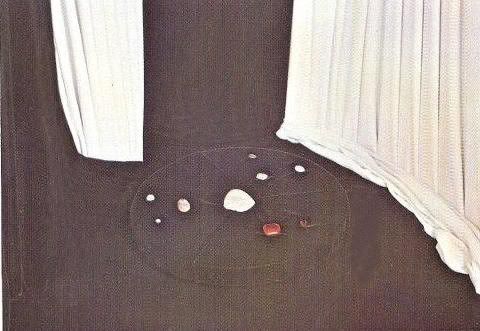
OPAL
Opal is the only principal gemstone that does not have a crystalline form as it is a solidified silica jelly. In precious opal very thin films of silica, varying slightly in composition, act on light in the same way as soap films, creatina an iridescent display of colour.
The two main classifications are black opal and white opal, the respective type being described according to the background colour.
Opals from the Hungarian mines were known and admired in Roman times but these stones have been completely overshadowed by the rich Australian opal deposits first discovered in 1889.
The large centre stone is a fine example or white opal weighing 126.75 carats. Included in the display are smaller specimens of black, white and matrix opal, the latter being a composite mixture of the opal with its host rock, both of which are polished to produce the gem.
The clear red stones are fire opal, a similar type of material usually faceted to reveal the rich colour.
CABINET No. 6
Lady Courtauld's Gemstone Collection

BERYL
Beryl is the genetic name for a group of gemstones many of which have their own distinctive names, depending on their colour. The best known is the emerald, the grass-green variety which owes its colour to chromium, whilst aquamarine denotes the blue and sea green varieties coloured by ferric iron. Lithium coloured rose pink beryl is often termed morganite and the golden yellow type heliodor; whatever the colouring agent, all are basically beryllium aluminium silicate which, if pure, would be colourless. Two exceptional specimens of the most desirable blue colour are displayed in this cabinet. The kite shaped stone weighs 49.56 carats and the rectangular stone, 41.47 carats. Emeralds are represented by some excellent pieces of rough material and a small string of carved emerald beads. The other stones are fine examples of the range of the beryl group of gems, from the point of view of colour as well as size.
End of Page 12 A
CABINET No. 7
Lady Courtauld's Gemstone Collection

DEMANTOID GARNET
These green stones are the most valuable of the garnet family of gemstones due to their rarity and beauty. The more common examples of garnet, in the red, yellow and orange colour ranges, are widely distributed throughout the world, whereas the green demantoid variety is found only in the Ural Mountains of Russia. One outstanding feature of the green demantoid gemstone is that it has a greater colour dispersion than diamond, although the "fire" which would otherwise be apparent is masked by the intrinsic colour of the stone.
The central gem weighs 16.02 carats and is believed to be the largest specimen in the world; it is flawless and without the usual "horsetail" fibrous inclusions. The other three stones, weighing 4.60, 5.89 and 8.96 carats, whilst not being of this exceptional quality, are collectors items, as specimens of 2 carats and upwards are exceedingly hard to obtain.
CABINET No. 8Lady Courtauld's Gemstone Collection
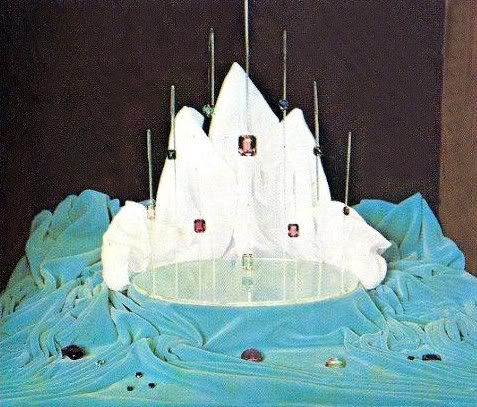
TOURMALINE
Tourmaline is a most interesting and attractive gemstone as no other gem species has such a wide variety of colour. This is undoubtedly due to the complexity of its composition. Basically it is a borosilicate of aluminium but many metals such as sodium, potassium, calcium, manganese, magnesium, titanium, iron, or lithium may be included in the composition of the stone.
Tourmaline is found in the pegmatites in the Miami/Karoi area of Rhodesia and also in small pieces in the Somabula gravels. The best material comes from Brazil, Russia and Madagascar, to mention a few of the localities where it occurs. Recently found deposits in Portuguese East Africa have produced material of exceptional size and colour variety.
The large salmon coloured stone in the centre of the display is a fine specimen weighing 93.50 carats.
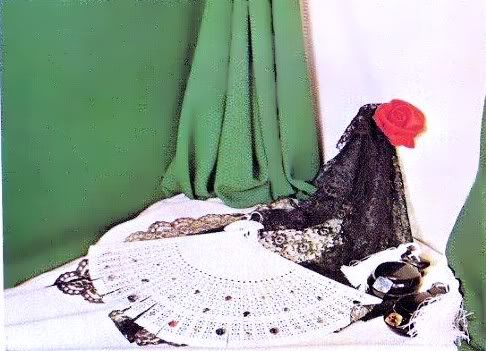
CORUNDUM (RUBY AND SAPPHIRE)
Corundum is the mineralogical name for two of the most popular gemstones, namely ruby and sapphire, which rank second to diamond alone in hardness. These gems are composed of aluminium oxide which, if pure, is quite colourless, but due to the fortunate presence of chromium and titanium, the splendid colours of ruby and sapphire are produced by minute amounts of these metals in the respective gems. Only the clear rich red corundum qualifies for the title of ruby, all other colours being termed "fancy sapphires". Burma rubies and Siam sapphires have long been regarded as the finest of their species in the world, although each territory produces quantities of both types of gem. In addition, Ceylonproduces rubies and sapphires in quantity but usually in paler shades. Attractive sapphires also emanate from Kashmir and Montana in the United States.
The collection is now not well endowed with rubies but there is a fine colour selection of sapphires, the largest being the pale blue stone weighing 53.77 carats.
CABINET No. 9
Lady Courtauld's Gemstone Collection
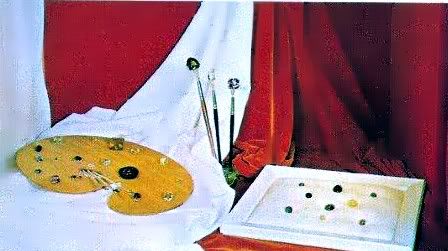
RARE STONES AND STAR STONES
Palette
1. Sphalerite (10 cts.)
2. Silica Glass (68.07 cts
3. Silica Glass (10.10 cts
4. Scopolite (16 cts.)
5. Danburite (3.59 cts.)
6. Danburite (14 36 cts.)
7. Sphalerite (17.14 cts.)
8. Amber (57.80 cts.)
9. Phenakite (20.15 cts.)
10. Hematite (14 cts.)
11. Moonstone (3.50 cts.)
12. Alexandrite (1.11 cts.)
13. Alexandrite (2£8 cts.)
14. Kunzite 15 20 cts.)
15. lolito (2.77 cts.)
16. Apatite (7.58 cts.)
17. Benitoite .48 cts.)
18. Obsidian (8.90 cts.)
19. Spodumono (23.85 cts.)
20. Sphene (2.47 cts.)
21. Diopside (3 cts.)
22. Cassitoritc (8.74 cts )
23. Peridot (69.65 cts.)
24. Spodumene (14.20 cts.)
25. Kunzite (56.72 eta.)
Picture Frame
26. Alexandrite Cats-Eye (5.24 cts.)
27. Star Garnet (28.08 cts.)
28. Apatite Cats-Eye (6.35 cts.)
29. Enstatite Cats-Eye (8.90 cts.)
30. Chrysobery! Cats-Eye (18.22)
31. Scapolite Cats-Eye (20.6 cts.)
32. Scapolite Cats-Eye (9 68 cts )
33. Star Sapphire (7.01 cts.)
34. Star Sapphire (9.08 cts.)
CABINET No. 11
Lady Courtauld's Gemstone Collection

SPINEL
Spinel is a magnesium aluminium oxide that has the misfortune of being overshadowed in almost all attributes by the more famous aluminium oxide gems, ruby and sapphire. As spinel is often found in the same mines as ruby and sapphire, it is the poor relation in its home locale, being excelled in hardness and colour by these corundum gems. Despite such detractions it is a desirable and attractive gem. exceeded in hardness only by chrysoberyl, corundum and diamond —being hardness 8 on Mohs scale compared with 8½. 9 and 10 respectively for the other stones mentioned.
This cabinet depicts the wide variety of colours of spinel. The samples shown probably originated from the three prime producing centres of Burma, Siam and Ceylon.
CABINET No. 12
Lady Courtauld's Gemstone Collection
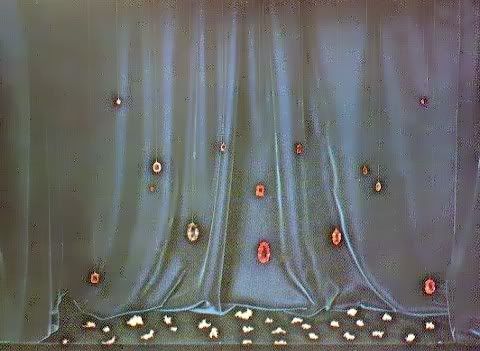
TOPAZ
Topaz is a fluosilicate of aluminium having a hardness of 8 and is therefore one of the harder gemstones. Although the name is usually associated with yellow gems of all shades from pale yellow to a rich sherry brown, topaz frequently occurs as a colourless stone and in shades of blue and pale green. Pink and red stones are rare in the natural state, but material of a brownish yellow colour, principally found in Brazil, may be transformed by the application of heat, to the more desired colours. Topaz has a strong tendency to cleavage parallel to the base of the natural crystal, a fact that recommends that these stones be treated with at least as much care as any gemstone deserves. The two largest stones, the orange-red and blue, which have been set in platinum, weigh 68.76 and 55.68 carats respectively.
The stones in this cabinet are the true topaz and should not be confused with yellow quartz gems so often sold under the more distinguished title.
CABINET No. 13
R. A. L Catley, Esq.
GEM MATERIALS AVAILABLE LOCALLY
This cabinet depicts a variety of materials that can be found or purchased in Rhodesia, for cutting or as mineral specimens. The majority of the items are of local origin; specific mention is made of the exceptions. In the front centre of the cabinet is a large specimen of clear quartz with areas of smoky and greenish material. Behind this specimen on the first step are five cut stones showing some of the colours occurring in quartz gems. On the same step to the extreme left are examples of polished Australian opal, two black and two white, with an unpolished doublet showing the precious opal layer on a common opal base. The yellow stones on the right are chrysoberyl and the red. garnets.
CABINET No. 14
L. J. Contat, Esq.
EMERALD, RUBY, BERYL
This display, kindly loaned by Mr. L. J. Contat, is of particular interest to Rhodesians as the emeralds are from the world famous Sandawana Mine discovered by Mr. L. J. Contat and Mr. C. J. Oosthuizen. The specimens of emerald in schist matrix are irreplaceable as they came from the area of the original discovery, and this pegmatite-schist contact was removed in the early development of the mine. It will be apparent from the intense green of the cut stones why these emeralds are so highly prized, for the majority of stones from other localities fall short of this rich pure colour.
The rubies on display, both cut and in their rough state in the host rock, are from the Umba Mine in Tanzania, which is situated to the north-east of Tanga; these specimens further evidence the increasing range and quality of gemstones originating on the African Continent.
On the left of the cabinet is a fine example of green beryl from the Miami/Karoi area and on the right are two specimens of golden beryl from the same area; these have been illuminated from below to display the clarity and colour of these exceptional specimens.
We hope that you enjoyed your visit
to
THE STANDARD BANK PERMANENT GEMMOLOGICAL EXHIBIT
and that this
Souvenir Brochure
will help you to recall some of nature's exceptional treasures which we have been fortunate in being able to display.
My visit was on .................................................
End of Booklet
Recompiled, by Eddy Norris, from a copy of the booklet made available by Diarmid Smith.
Thanks Diarmid.
The recompilation was done for no or intended financial gain but rather to record the memories of Rhodesia.
Thanks to
Paul Norris for the ISP sponsorship.
Paul Mroz for the image hosting sponsorship.
Robb Ellis for his assistance.
Further information on the Courtauld's can be obtained by visiting these links:-
http://en.wikipedia.org/wiki/Stephen_Courtauld
http://www.lifenets.org/malawi/larochel.htm
Should you wish to contact Eddy Norris please mail him on orafs11@gmail.com
Lady Courtauld's Gemstone Collection

TOPAZ
Topaz is a fluosilicate of aluminium having a hardness of 8 and is therefore one of the harder gemstones. Although the name is usually associated with yellow gems of all shades from pale yellow to a rich sherry brown, topaz frequently occurs as a colourless stone and in shades of blue and pale green. Pink and red stones are rare in the natural state, but material of a brownish yellow colour, principally found in Brazil, may be transformed by the application of heat, to the more desired colours. Topaz has a strong tendency to cleavage parallel to the base of the natural crystal, a fact that recommends that these stones be treated with at least as much care as any gemstone deserves. The two largest stones, the orange-red and blue, which have been set in platinum, weigh 68.76 and 55.68 carats respectively.
The stones in this cabinet are the true topaz and should not be confused with yellow quartz gems so often sold under the more distinguished title.
CABINET No. 13
R. A. L Catley, Esq.
GEM MATERIALS AVAILABLE LOCALLY
This cabinet depicts a variety of materials that can be found or purchased in Rhodesia, for cutting or as mineral specimens. The majority of the items are of local origin; specific mention is made of the exceptions. In the front centre of the cabinet is a large specimen of clear quartz with areas of smoky and greenish material. Behind this specimen on the first step are five cut stones showing some of the colours occurring in quartz gems. On the same step to the extreme left are examples of polished Australian opal, two black and two white, with an unpolished doublet showing the precious opal layer on a common opal base. The yellow stones on the right are chrysoberyl and the red. garnets.
CABINET No. 14
L. J. Contat, Esq.
EMERALD, RUBY, BERYL
This display, kindly loaned by Mr. L. J. Contat, is of particular interest to Rhodesians as the emeralds are from the world famous Sandawana Mine discovered by Mr. L. J. Contat and Mr. C. J. Oosthuizen. The specimens of emerald in schist matrix are irreplaceable as they came from the area of the original discovery, and this pegmatite-schist contact was removed in the early development of the mine. It will be apparent from the intense green of the cut stones why these emeralds are so highly prized, for the majority of stones from other localities fall short of this rich pure colour.
The rubies on display, both cut and in their rough state in the host rock, are from the Umba Mine in Tanzania, which is situated to the north-east of Tanga; these specimens further evidence the increasing range and quality of gemstones originating on the African Continent.
On the left of the cabinet is a fine example of green beryl from the Miami/Karoi area and on the right are two specimens of golden beryl from the same area; these have been illuminated from below to display the clarity and colour of these exceptional specimens.
We hope that you enjoyed your visit
to
THE STANDARD BANK PERMANENT GEMMOLOGICAL EXHIBIT
and that this
Souvenir Brochure
will help you to recall some of nature's exceptional treasures which we have been fortunate in being able to display.
My visit was on .................................................
End of Booklet
Recompiled, by Eddy Norris, from a copy of the booklet made available by Diarmid Smith.
Thanks Diarmid.
The recompilation was done for no or intended financial gain but rather to record the memories of Rhodesia.
Thanks to
Paul Norris for the ISP sponsorship.
Paul Mroz for the image hosting sponsorship.
Robb Ellis for his assistance.
Further information on the Courtauld's can be obtained by visiting these links:-
http://en.wikipedia.org/wiki/Stephen_Courtauld
http://www.lifenets.org/malawi/larochel.htm
Should you wish to contact Eddy Norris please mail him on orafs11@gmail.com
Labels: Aggression. Rhodesia. Booklet, Gemstone, Old Umtali. J.H. Jeffreys. J.A. Palmer
